- Home
- Landscape drawing
Landscape in Colored Pencil
Have you ever considered drawing a landscape in colored pencil? It may not be the first subject that comes to mind, as you are more likely to see pet or human portraits rendered in this medium.
The sheer amount of detail to be included can put many artists off using this art medium, but if you look at each element of the landscape in turn it is more than possible to produce a realistic colored pencil landscape drawing. Then there is all that green! Rest assured that when you begin drawing landscapes you will start to see a multitude of other hues.
We have a complete tutorial for the picture below, along with many others, but let's start by looking at the basics of how to draw a landscape with colored pencil.
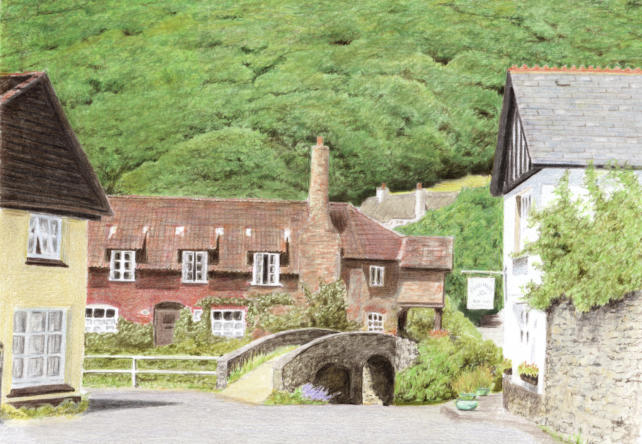
The first steps
Most artists will want to start with some sort of a tonal thumbnail sketch, even if they ultimately wish to render the subject in colored pencil.
However, you don't want to get too bogged down at this stage by worrying about too many details. Instead, think more about mapping out the basic shapes of your elements and getting the overall composition worked out.
This is best done outside or en plein air as you can move a few inches and draw landscapes that differ slightly each time. Using a photo reference for these first sketches restricts you to one viewpoint.
If you do work from a photo, it doesn't mean you have to slavishly replicate it. It may help the composition to move things around or omit them entirely.
Think about placing your focal point (the main area of interest) where the lightest light meets the darkest dark. Ideally, you will position this according to the rule of thirds or the Golden Section.
Your light source
In rural scenes, your light will come from a single direction (although trees or other obstacles may diffuse it).
In townscapes, your light may come from several directions and therefore needs to be carefully observed. You could have lamps alongside a road or shining from inside houses to contend with.
A light source could cast a different hue depending on the time of day; at sunrise, it could be more orange, whereas a cloudless sky will create a blue cast.
You can learn more about color temperature in our colour theory section.
The Elements Of A Colored Pencil Landscape
You may want to include a building in the distance when you draw landscapes. Therefore, we have a page on walls made from brick or stone for you to study, along with another covering the different types or roofs you may encounter.
Of course, linear perspective will be something to keep in mind, so there is a page to help you avoid drawing buildings that are off-kilter.
There is also ariel perspective to consider, this will help you viewer separate the elements and add a sense of depth when you draw a landscape.
Trees
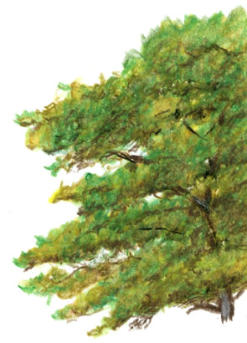
Landscape often contain trees, which artist's can find challenging due to the variety of foliage shapes, and colors.
The first thing to consider is the basic shape of a tree and we talk about this in detail on the how to draw trees and foliage page.
Our second workshop shows how to draw a hillside covered in trees and bushes. It teaches you what to look for when drawing trees.
We also have a tutorial showing how to draw the tree shown here using watercolor pencils.
The most compelling feature of trees is their three-dimensionality. Some branches will stick out from behind others, and these may cross in front or behind the main trunk. You will need to plan where your main light source is and set that as your point of reference. As you work, note the contrast in tone between the light and shaded areas.
Planning the position of the leaves on the branches will help to control the shape of the finished tree.
Your foliage should form a hazy mass of color, not a precise outline. In autumn, yellow and brown rather than greens are best, but in spring use plenty of light green and olive green.
You can use an eraser to thin out the foliage and create "sky holes" among your branches. An eraser is also useful for softening the top edges of the foliage so your trees don't end in a definite line.
When drawing winter trees, your erase can also lift out pigment to create snow lying on the branches.
Grasses, weeds and flowers
Grasses and weeds often feature in the foreground of your landscapes. The closer to the viewer they are, the more detail you will need to include.
Starting with the shadows and ensuring they are dark enough helps to bring the lighter areas forward. Even these deep darks should have some tone and color variation to hint at something going on without making it too obvious. Vary your pressure on the colored pencils to help achieve this.
To look natural, avoid having the grass all on one level and growing in the same direction. Allow the blades to criss-cross, bend, and fold to create an illusion of depth. Those that are closer to the viewer can cause shadows across those that are further away.
Also, consider the time of year. If your landscape drawing depicts summer the colours will consist of yellows and browns rather than light and dark green.
Our tutorial of Brokken Bridge illustrates watercolour pencil techniques for foreground grass.
In summer you may also find flowers in the foreground of your image. They add a splash of color, but this can attract the viewer's eye and pull their attention from the midground and focal point of your artwork so think carefully before you go to town with your colored pencils.
If your drawing is more intimate in nature, you can make a feature of the flowers as in Peter's Garden Archway tutorial.
Skies and clouds
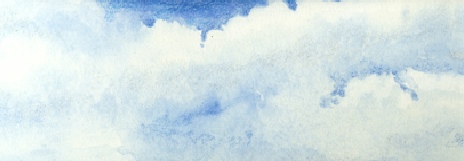
Look at an actual blue sky and record the range of blues you see, from the darkest blues above your head to the lightest shades on the horizon.
If you use light pressure when drawing your skies you will find that clouds lift out easily with an eraser ensuring soft edges and not distinct lines.
For a detailed guide on creating subtle, layered backgrounds with watercolor pencils, check out our step-by-step background painting tutorial.
Adding shadows to the bottom of your clouds show that the light from the sun overhead is not reaching them directly adding realism to your art. However, be wary of making these too dark or you will end up with clouds that appear so heavy they defy gravity!
Do you remember lying on the grass and looking up at the sky when you were a child? Try it again and study the shapes and sizes of the clouds, note how they change depending on whether you look directly overhead or off to the distance. Observation like this is immensely valuable to an artist even if to other people it may look as though you are relaxing!
You have your whole pencil collection available to you when drawing skies and clouds, except the greens!
Check out our page covering various techniques for drawing clouds.
Stone and brick in landscape drawing
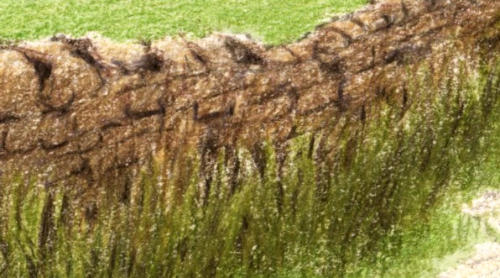
Stones or rocks often appear within the landscape, whether naturally occurring or used by man to form structures such as walls or buildings
Although you can depict their texture with a scribble stroke, careful attention is still required to take note of the shadows and highlights.
The weather depicted in your colored pencil landscape will also determine the techniques you will use. If it has been raining you can burnish your stones to make them appear wet and shiny. In dryer conditions, you can leave the tooth of the paper showing to emphasize the grainy texture of the rocks.
The variety of these hard, rough landscape elements is vast so we will study how we can suggest these textures in our landscape drawing.
Our Dartmoor scene depicting the Bowerman Stone provides instructions on creating rough textured rocks in addition to fields and sky.
Water
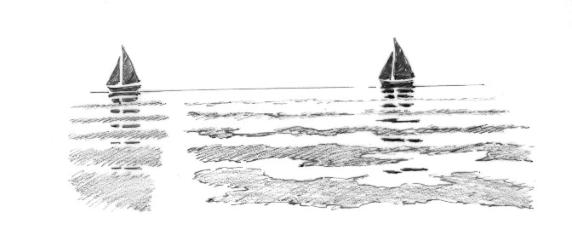
Rivers, ponds and lakes are popular additions in landscape drawing.
Then of course you have the mighty ocean, although you are then moving into the realms of seascapes where you can really play with color and contrast it against the foam and spray of the waves. Here you would keep your cooler colors at the horizon and change to turquoise in the foreground.
Amateur artists often make the mistake of making all water in their drawings blue, when in fact the hues from the surrounding landscape are reflected in it.
The wind (or lack of it) will affect how accurately elements are reflected in the surface. Careful observation is necessary rather than guesswork here.
If you find yourself struggling, turn your reference photograph and drawing upside down so that your eye only sees shapes and colors. This helps you focus on seeing rather than naming things.
We go into more detail about drawing reflections in water with the help of illustrations and photographs here. If you want to place a boat on your water, we also provide an exercise on another page that will help get the boat's proportions correct.




